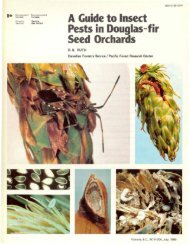decay of aspen and balsam poplar in alberta - Canadian Forest ...
decay of aspen and balsam poplar in alberta - Canadian Forest ...
decay of aspen and balsam poplar in alberta - Canadian Forest ...
Create successful ePaper yourself
Turn your PDF publications into a flip-book with our unique Google optimized e-Paper software.
DECAY OF ASPEN AND BALSAM POPLAR IN ALBERTA<br />
Y. Hiratsuka <strong>and</strong> A. A. Lomanl<br />
INFORMATION REPORT NOR-X-262<br />
NORTHERN FOREST RESEARCH CENTRE<br />
CANADIAN FORESTRY SERVICE<br />
ENVIRONMENT CANADA<br />
1984<br />
I Loman <strong>and</strong> Associates, 4915 Vanguard Road N.W., Calgary Alberta T3A ORS
j<br />
©M<strong>in</strong>ister <strong>of</strong> Supply <strong>and</strong> Services Canada 1984<br />
Catalogue No. F046·12/262E<br />
ISBN 0·662·13377-3<br />
ISSN 0704· 7673<br />
This publication is available at no charge from:<br />
Northern <strong>Forest</strong> Research Centre<br />
<strong>Canadian</strong> <strong>Forest</strong>ry Service<br />
Environment Canada<br />
5320 - 122 Street<br />
Edmonton, Alberta<br />
T6H 3S5<br />
II
Hiratsuka, Y.; Loman, A.A. 1984. Decay <strong>of</strong> <strong>aspen</strong> <strong>and</strong> <strong>balsam</strong> <strong>poplar</strong> <strong>in</strong> Alberta. Environ. Can., Can. For. Serv.,<br />
North. For. Res. Cent., Edmonton, Alberta. Inf. Rep. NOR·X·262.<br />
ABSTRACT<br />
Aspen (Po/>ulus tremuloides Michx.) <strong>and</strong> <strong>balsam</strong><br />
<strong>poplar</strong> (P. <strong>balsam</strong>ifera L. ) represent about 40% <strong>of</strong><br />
Alberta's forest resources, but utilization is only 1% <strong>of</strong><br />
the total available. Decay <strong>and</strong> sla<strong>in</strong> are two major factors<br />
limit<strong>in</strong>g utilization <strong>of</strong> these species. Major <strong>decay</strong>-caus<strong>in</strong>g<br />
agents <strong>and</strong> types <strong>of</strong> <strong>decay</strong> <strong>of</strong> <strong>aspen</strong> <strong>and</strong> <strong>balsam</strong> <strong>poplar</strong><br />
are reviewed, <strong>and</strong> the implications for management <strong>and</strong><br />
utilization are discussed.<br />
III<br />
RESUME<br />
Le peuplier faux-tremble (Populus tremuloides<br />
Michx.) et Ie peuplier baumier (P. <strong>balsam</strong>ifera L.)<br />
constituent environ 40% des ressources forestieres de<br />
l'Alberta, rnais leur utilisation ne s'eleve qu'a 1 % du total<br />
disponible. Les deux pr<strong>in</strong>cipaux facteurs limitant leur<br />
utilisation sont la carie et les taches colones. Les<br />
pr<strong>in</strong>cipaux agents et les types de caries observes chez ces<br />
deux essences sont discutes, de meme que leurs<br />
repercussions sur I'amenagement et I'utilisation de ces<br />
essences.
CONTENTS<br />
INTRODUCTION ............................. ............. ........................... 1<br />
MAJOR DECA Y·CAUSING AGENTS AND TYPES OF DECA Y .. ........................... 1<br />
AGE·DECA Y RELATIONSHIPS. . . . . .... .. . . .... . .... . . . . .. ... .... . .... .. .. . . .. . . . . . .. .. 9<br />
SITE· DECAY RELATIONSHiPS ...... .. ...... ........ ............... ................... 9<br />
CLONE·DECA Y RELATIONSHIPS . . . . . . . . . . . . . . . . .. . . . . . . . . . . . . . . . . . . . . . . . . . . . . . . . . . . . . 10<br />
CULL EST IMATION WITH EXTERNAL INDICATORS .. ........ ............. ...... ....... 12<br />
ASPEN AND BALSAM POPLAR DECAY MANAGEMENT.. .................. ............. 14<br />
SIGNIFICANCE OF DECAY AND DISCOLORATION TO ASPEN AND BALSAM POPLAR<br />
UTIL IZATION ................... .................... .................... ......... 16<br />
Plywood......................... ................ . ............................. 16<br />
Dimension lumber t boards, <strong>and</strong> timbers ..................................... ........ .<br />
Wafer board. flakeboar, chipboard, <strong>and</strong> oriented str<strong>and</strong> board. . . . . . . . . . . . . . . . . . . . . . . . . . . 16<br />
Pulp <strong>and</strong> paper .. ..................... ............... .................... ...... . 16<br />
Integrated wood products complex. . . . . . . . . . . . . . . . . . . . . . . . . . . . . . . . . . . . . . . . . . . . . . . . . . 16<br />
Conversion <strong>of</strong> biomass <strong>in</strong>to energy <strong>and</strong> chemicals . . . . . . . . . . . . . . . . . . . . . . . . . . . . . . . . . . . . . . 1 7<br />
Cattle feed. . . . . . . . . . . . . . . . . . . . . . . . . . . . . . . . . . . . . . . . . . . . . . . . . . . . . . . . . . . . . . . . . . . . . 17<br />
Cultivation <strong>of</strong> edible mushrooms. . . . . . . . . . . . . . . . . . . . . . . . . . . . . . . . . . . . . . . . . . . . . . . . . . . . 17<br />
CONCLUSIONS. . . . . . . . . . . . . . . . . . . . . . . . . . . . . . . . . . . . . . . . . . . . . . . . . . . . . . . . . . . . . . . . . . . . . . . 17<br />
RECOMMENDATIONS . . . . . . . . . . . . . . . . . . . . . . . . . . . . . . . . . . . . . . . . . . . . . . . . . . . . . . . . . . . . . . . . 17<br />
REFERENCES 18<br />
FIGURES<br />
1.. Poplar distribution across Canada <strong>and</strong> estimated gross merchantable volume for each prov<strong>in</strong>ce or<br />
region.. . . ... . . . . . . . . . . .. . . . . .. . . ... . . . . .. . . . . . . . . . . . . .. . . . .. . . . . . . . ... . . . . . . . .. . . 2<br />
2. Potential annual forest yield <strong>of</strong> coniferous <strong>and</strong> deciduous (mostly <strong>poplar</strong>) species <strong>in</strong> Alberta. . . . . . . . 3<br />
3. Pure <strong>aspen</strong> st<strong>and</strong> along a logg<strong>in</strong>g road near Blue Ridge, Alberta . . . . . . . . . . . . . . . . . . . . . . . . . . . . . 4<br />
4. A st<strong>and</strong> <strong>of</strong> mature <strong>aspen</strong> near Blue Ridge, Alberta, after s<strong>of</strong>twood harvest . . . . . . . . . . . . . . . . . . . . . 4<br />
5. Vertical section <strong>of</strong> an <strong>aspen</strong> stem with fruit<strong>in</strong>g body <strong>of</strong> Phell<strong>in</strong>us tremulae <strong>and</strong> a column <strong>of</strong> advanced<br />
<strong>decay</strong> bordered by characteristic black l<strong>in</strong>es. . . . . . . . . . . . . . . . . . . . . . . . . . . . . . . . . . . . . . . . . . . . . . 5<br />
6. Cross section <strong>of</strong> an <strong>aspen</strong> stem with advanced <strong>decay</strong> caused by Phell<strong>in</strong>us tremulae . . . . . . . . . . . . . . 5<br />
7. Relation <strong>of</strong> rotten knot <strong>and</strong> <strong>decay</strong> column <strong>of</strong> Phell<strong>in</strong>us tremulae <strong>in</strong> <strong>aspen</strong> . ....... .............. 5<br />
8. A fruit<strong>in</strong>g body (conk) <strong>of</strong> Phell<strong>in</strong>us tremulae on <strong>aspen</strong> . ... . . . . . . . . .. . .. . . . . . . . . . .. . . . . ... . . 5<br />
9. Fruit<strong>in</strong>g structure <strong>of</strong> Peniophora polygonia on <strong>aspen</strong>. . . . . . . . . . . . . . . . . . . . . . . . . . . . . . . . . . . . . . . 7<br />
10. Large scars (cracks) on mature <strong>balsam</strong> <strong>poplar</strong>. . . ... . . .. . . . ... . .. .. . . . .. . ... .. .. . . . . . . .. . . 7<br />
11. Dead branch <strong>and</strong> column <strong>of</strong> discolored <strong>in</strong>cipient <strong>decay</strong> <strong>of</strong> <strong>aspen</strong> caused by Peniophora polygonia . . . 7<br />
12. Fruit<strong>in</strong>g bodies (mushrooms) <strong>of</strong> Pholiota destruens on <strong>balsam</strong> <strong>poplar</strong>. . . . . . . . . . . . . . . . . . . . . . . . . . 7<br />
13. Brown butt rot <strong>of</strong> <strong>balsam</strong> <strong>poplar</strong>. probably caused by Armillaria mellea . . . . . . . . . . . . . . . . . . . . . . . 8<br />
14. Butt rot (brown rot) <strong>of</strong> <strong>aspen</strong> caused by Armillaria mellea . . . . . . . . . . . . . . . . . . . . . . . .. . . . . . . . . . 8<br />
IV<br />
Page
15. Black gall on <strong>aspen</strong> . . . . . . . . . . . . . . . . . . . . . . . . . . . . . . . . . . . . . . . . . . . . . . . . . . . . . . . . . . . . . . . . . 8<br />
16. Representation <strong>of</strong> average tree dimensions <strong>and</strong> size, position, <strong>and</strong> shape <strong>of</strong> <strong>decay</strong> columns <strong>in</strong> some <strong>aspen</strong><br />
clones <strong>in</strong> two Manitoba locations (Manigotogan <strong>and</strong> Robl<strong>in</strong>). . . . . . . . . . . . . . . . . . . . . . . . . . . . . . . . . 11<br />
17. Decay <strong>of</strong> <strong>balsam</strong> <strong>poplar</strong> show<strong>in</strong>g a scar <strong>and</strong> a branch knot as the entry po<strong>in</strong>ts for an unknown <strong>decay</strong><br />
organism . . . . . . . . . . . . . . . . . . . . . . . . . . . . . . . . . . . . . . . . . . . . . . . . . . . . . . . . . . . . . . . . . . . . . . . . : . 13<br />
18. Extensve stem damage at the bottom <strong>of</strong> a mature <strong>balsam</strong> <strong>poplar</strong> . . . . . . . .. . . . . . . . . ... . . : ... , . . 13<br />
19. An old healed wound on a small diameter <strong>aspen</strong> with fruit<strong>in</strong>g bodies <strong>of</strong> Peniophora polygonia. . . . .. 13<br />
20. A long scar on a mature <strong>aspen</strong> with conks <strong>of</strong> Phell<strong>in</strong>us tremulae . . . . . . . . . . . . . . . . . . . . . . . . . . . . . 13<br />
TABLES<br />
1. Percentage <strong>in</strong>fections by major <strong>decay</strong>-caus<strong>in</strong>g fungi on <strong>aspen</strong> <strong>and</strong> <strong>balsam</strong> <strong>poplar</strong> <strong>in</strong> the Slave Lake area<br />
<strong>of</strong> Alberta. . . .. . . . . . . .. . . . .. .. . . .. .. . . . .. .. . .. . . . .. . . .. . . .. . . .. . . . . . .. . . .. . . . . . 9<br />
2. Age-<strong>decay</strong> relationships <strong>in</strong> <strong>aspen</strong> st<strong>and</strong>s <strong>in</strong> Canada <strong>and</strong> the United States . . _ _ . . _ . . _ . . . . . . . . . . . . 10<br />
3. Age-<strong>decay</strong> relationships <strong>in</strong> <strong>balsam</strong> <strong>poplar</strong> st<strong>and</strong>s <strong>in</strong> Alberta . . . . . . . . . . . . . . . . . . . . . . . . . . . . . . . _ . 12<br />
4. Relationship between visible Phell<strong>in</strong>us tremulae fruit<strong>in</strong>g bodies <strong>and</strong> the occurrence <strong>of</strong> <strong>decay</strong> <strong>in</strong><br />
<strong>aspen</strong> _ . . . .. . . .. . . . . . . . . . . . .. . . . . . . . . .. . . . . . . . . . .. . . . . . . . . .. . . _ . . . . . . . . . . . . . . . . . . . 15<br />
5. Relationship between <strong>decay</strong> <strong>and</strong> sta<strong>in</strong> occurrence <strong>and</strong> external <strong>in</strong>dicators <strong>in</strong> <strong>aspen</strong> sampled at Blue<br />
Ridge, Alberta, <strong>in</strong> 1982.... ... .. .... .... ... .... .... .. ...... .. ... .... .... .... ... .. . ... 15<br />
v
Hardwoods, mostly <strong>aspen</strong> (Populus tremuloides<br />
Michx.) <strong>and</strong> <strong>balsam</strong> <strong>poplar</strong> (P. <strong>balsam</strong>ifera L. ), repre·<br />
sent about 40% <strong>of</strong> Alberta's forest resources. Current<br />
utilization amounts to only about 1 % <strong>of</strong> the total, but the<br />
time is fast approach<strong>in</strong>g when the s<strong>of</strong>twood resources will<br />
be harvested to their limits <strong>of</strong> annual allowable cut. The<br />
<strong>aspen</strong>·<strong>balsam</strong> <strong>poplar</strong> resource will then be expected to<br />
play a much more significant role <strong>in</strong> meet<strong>in</strong>g the dem<strong>and</strong><br />
for forest products <strong>in</strong> the future. The relative amounts <strong>of</strong><br />
hardwood (mostly <strong>poplar</strong>) volume across Canada <strong>and</strong><br />
potential annual allowable cut <strong>in</strong> Alberta are shown <strong>in</strong><br />
Figures 1 <strong>and</strong> 2. Typical <strong>aspen</strong> forests <strong>in</strong> Alberta are<br />
illustrated <strong>in</strong> Figures 3 <strong>and</strong> 4. Three other <strong>poplar</strong> species<br />
(black cottonwood, P. trichocarpa Torr. & Gray; eastern<br />
cottonwood, P. deltoides Bartr.; <strong>and</strong> narrowleaf cotton<br />
wood, P. angustifolia James) also occur <strong>in</strong> Alberta, but<br />
they are economically <strong>in</strong>significant.<br />
Decay <strong>and</strong> sta<strong>in</strong> have been identified as two <strong>of</strong> the<br />
most important factors limit<strong>in</strong>g the utilization <strong>of</strong> <strong>aspen</strong><br />
<strong>and</strong> <strong>balsam</strong> <strong>poplar</strong>. Several terms used <strong>in</strong> this report are<br />
def<strong>in</strong>ed as follows: Incipient <strong>decay</strong> <strong>in</strong>dicates an early<br />
stage <strong>of</strong> <strong>decay</strong> <strong>in</strong> which the wood is hard <strong>and</strong> firm but<br />
may show discoloration or dark l<strong>in</strong>es. Advanced <strong>decay</strong><br />
refers to an advanced stage <strong>of</strong> <strong>decay</strong> <strong>of</strong> wood that is<br />
s<strong>of</strong>tened <strong>and</strong> has lost structural strength. Sta<strong>in</strong> is a<br />
discoloration <strong>of</strong> wood by microoganisms or other physio<br />
logical causes <strong>and</strong> may or may not be the early stage <strong>of</strong><br />
<strong>in</strong>cipient <strong>decay</strong>.<br />
INTRODUCTION<br />
Many reports conta<strong>in</strong><strong>in</strong>g <strong>in</strong>formation on <strong>decay</strong> <strong>of</strong><br />
<strong>aspen</strong> <strong>and</strong> <strong>balsam</strong> <strong>poplar</strong> ha ve been published <strong>in</strong> various<br />
parts <strong>of</strong> North America, <strong>in</strong>clud<strong>in</strong>g Alberta. The most<br />
significant <strong>and</strong> relevant contributions are the follow<strong>in</strong>g:<br />
Alberta (Bailey <strong>and</strong> Dobie 1977; Paul <strong>and</strong> Etheridge<br />
1958; Thomas et al. 1960), Manitoba <strong>and</strong> Saskat·<br />
chewan (Wall 1971; Black <strong>and</strong> Kristapovich 1954),<br />
Ontario (Basham 1958, 1979; Riley 1952), Colorado<br />
(Davidson et al. 1959; H<strong>in</strong>ds <strong>and</strong> Wengert 1977), <strong>and</strong><br />
M<strong>in</strong>nesota (Me<strong>in</strong>ecke 1929). Unfortunately, the above·<br />
mentioned reports <strong>and</strong> many others written on the subject<br />
are not easily accessible because they have been<br />
reported mostly <strong>in</strong> specialized scientific journals or<br />
unpublished government reports.<br />
The purpose <strong>of</strong> this report is to compile <strong>and</strong> review<br />
available <strong>in</strong>formation on <strong>decay</strong> <strong>of</strong> <strong>aspen</strong> <strong>and</strong> <strong>balsam</strong><br />
<strong>poplar</strong> <strong>and</strong> to attempt to <strong>in</strong>terpret it <strong>in</strong> relation to <strong>aspen</strong><br />
<strong>poplar</strong> management <strong>and</strong> utilization <strong>in</strong> Alberta.<br />
This report was prepared orig<strong>in</strong>ally for the Alberta<br />
Poplar Research Committee, composed jo<strong>in</strong>tly <strong>of</strong><br />
personnel from the Alberta <strong>Forest</strong> Service (J. Soos,<br />
B. Karaim, <strong>and</strong> E. Gillespie) <strong>and</strong> Blue Ridge Lumber<br />
(1981) Ltd. (M. Summers, P. Caldwell, <strong>and</strong> R. Kerr)<br />
<strong>and</strong> chaired by A.D. Kiil <strong>of</strong> the <strong>Canadian</strong> <strong>Forest</strong>ry<br />
Service.<br />
MAJOR DECAY-CAUSING AGENTS AND TYPES OF DECAY<br />
Many fungi have been isolated <strong>and</strong> identified from<br />
<strong>decay</strong> <strong>and</strong> sta<strong>in</strong> <strong>of</strong> <strong>aspen</strong> <strong>and</strong> <strong>balsam</strong> <strong>poplar</strong> (Basham<br />
1958; Gilbertson 1981; H<strong>in</strong>ds <strong>and</strong> Wengert 1977;<br />
L<strong>in</strong>dsey <strong>and</strong> Gilbertson 1978; Thomas et aI. 1960; Wall<br />
1971). Fourteen major <strong>decay</strong> fungi have been isolated<br />
<strong>and</strong> identified from <strong>in</strong>cipient <strong>and</strong> advanced <strong>decay</strong> <strong>in</strong><br />
<strong>aspen</strong> <strong>and</strong> <strong>balsam</strong> <strong>poplar</strong> <strong>in</strong> the Slave Lake area <strong>of</strong><br />
Alberta by Thomas et al. (1960) (Table I). Accord<strong>in</strong>g<br />
to Thomas et al., Phell<strong>in</strong>us tremulae (Fomes igniarius)<br />
is the most common <strong>and</strong> important <strong>decay</strong>-caus<strong>in</strong>g<br />
organism <strong>in</strong> both <strong>aspen</strong> <strong>and</strong> <strong>balsam</strong> <strong>poplar</strong>. This species<br />
has also been identified as the ma<strong>in</strong> <strong>decay</strong> organism <strong>of</strong><br />
<strong>aspen</strong> <strong>in</strong> other parts <strong>of</strong> North America (Basham 1958;<br />
Black <strong>and</strong> Kristapovich 1954; H<strong>in</strong>ds <strong>and</strong> Wengert 1977;<br />
Me<strong>in</strong>ecke 1929; Wall 1971). This fungus is commonly<br />
called the false t<strong>in</strong>der fungus <strong>and</strong> causes s<strong>of</strong>t yellowish<br />
<strong>and</strong> characteristic brown to blackish brown l<strong>in</strong>es surround<br />
<strong>in</strong>g each <strong>decay</strong> column (Figs. 5· 7). Ho<strong>of</strong>·shaped sporo·<br />
phores (conks) <strong>of</strong> P. tremulae are about 10 em <strong>in</strong> width<br />
(Fig. 8). The upper side <strong>of</strong> the sporophore is greyish<br />
black at first <strong>and</strong> later becomes cracked <strong>and</strong> appears<br />
c<strong>in</strong>der·like. The undersurface is covered with brown to<br />
whitish-brown spore-produc<strong>in</strong>g tubes. The <strong>in</strong>terior <strong>of</strong><br />
a conk is dark brown (Fig. 5).<br />
On <strong>aspen</strong>, Radulum casearium <strong>and</strong> Peniophora<br />
polygonia (Corticium polygonium) have been commonly<strong>and</strong><br />
constantly isolated from yellowish or reddish<br />
str<strong>in</strong>gy rot <strong>and</strong> from variously colored (brown, yellow,<br />
red) <strong>in</strong>cipient <strong>decay</strong>s. They are considered to be the next<br />
most important <strong>aspen</strong> <strong>decay</strong> after P. tremulae (Basham<br />
1958; Black <strong>and</strong> Kristapovitch 1954; Laflamme <strong>and</strong><br />
Lortie 1973; Thomas et al. 1960; Wall 197 1).<br />
Characteristically, P. polygonia has been isolated<br />
from younger <strong>aspen</strong> trees, <strong>and</strong> most isolations were from<br />
<strong>in</strong>cipient <strong>decay</strong> (Basham 1958). Sporophores <strong>of</strong><br />
P. polygonia are <strong>of</strong>ten observed on branch stubs <strong>of</strong> trees<br />
1
2<br />
Figure 1.<br />
337<br />
255<br />
D 0 0 0<br />
B.C. Alta. Sask. Man. Onto Que. Maritimes<br />
175 171<br />
Poplar volume (millions <strong>of</strong> m3)<br />
42<br />
c:::J<br />
,- . ,-<br />
Poplar distribution across Canada (shaded area) <strong>and</strong> estimated gross merchantable volume for<br />
each prov<strong>in</strong>ce or region (based on Bonnor 1982).
4b?na<br />
CANADA<br />
PEA CE RIVER FORE ST<br />
C 1138<br />
D 1 950<br />
FOOTNER LAKE FOREST<br />
C 1 564<br />
02150<br />
r--- WHITECOURT FOREST<br />
EDSON FOREST<br />
POTENTIAL ANNUAL<br />
FOREST YIELD<br />
1980<br />
C 1280 CONIfeROUS VOLUME IN THOUSANDS<br />
OF CUBIC METRES PER YEAR<br />
0510<br />
DECIDUOUS VOLUME IN THOUSANDS<br />
OF CUBIC METRES PER YEAR '<br />
C 1446<br />
01250<br />
SLAVE LAKE<br />
FOREST<br />
C 1765<br />
02 970<br />
WOOD<br />
W A TERTON LAKES<br />
.... .<br />
NATIONAL PARK<br />
BUFFALO<br />
NATIONAL<br />
PAAK<br />
ATHABASCA<br />
FOREST<br />
C 1 432<br />
o 880<br />
LAC LA BICHE<br />
FOREST<br />
C 761<br />
D 1190<br />
Figure 2. Potential annual forest yield <strong>of</strong> coniferous <strong>and</strong> deciduous (mostly <strong>poplar</strong>) species <strong>in</strong> Alberta.<br />
(Alberta <strong>Forest</strong> Service map.)<br />
3
4<br />
Figure 3. Pure <strong>aspen</strong> st<strong>and</strong> along a logg<strong>in</strong>g road near Blue Ridge, Alberta. Figure 4. A st<strong>and</strong> <strong>of</strong> mature <strong>aspen</strong><br />
near Blue Ridge, Alberta, after s<strong>of</strong>twood harvest.
Figure 5. Vertical section <strong>of</strong> an <strong>aspen</strong> stem with a fruit<strong>in</strong>g body <strong>of</strong> Phell<strong>in</strong>us lremulae <strong>and</strong> a column <strong>of</strong> advanced<br />
<strong>decay</strong> bordered by characteristic black l<strong>in</strong>es. Figure 6. Cross section <strong>of</strong> an <strong>aspen</strong> stem with advanced <strong>decay</strong><br />
caused by Phell<strong>in</strong>us tremulae. Figure 7. Relation <strong>of</strong> rotten knot <strong>and</strong> <strong>decay</strong> column <strong>of</strong> Phell<strong>in</strong>us tremulae <strong>in</strong><br />
<strong>aspen</strong>. Figure 8. A fruit<strong>in</strong>g body (conk) <strong>of</strong> Phell<strong>in</strong>us tremulae on <strong>aspen</strong>.<br />
5
:1<br />
;'<br />
i<br />
:!<br />
6<br />
Table 1. Percentage <strong>in</strong>fections by major <strong>decay</strong>caus<strong>in</strong>g fungi on <strong>aspen</strong><br />
<strong>and</strong> <strong>balsam</strong> <strong>poplar</strong> <strong>in</strong> the Slave Lake area <strong>of</strong> Alberta. Based on<br />
Thomas et al. (1960).<br />
Trunk<br />
Phell<strong>in</strong>us tremulae 13.4<br />
(=Fomes igniarius)<br />
Radulum casearium 14.2<br />
Peniophora polygonia 12.8<br />
(=Corticium polygonium)<br />
Coriolus zonulus 2. 1<br />
(=Polyporus zonulus)<br />
Bjerk<strong>and</strong>ra adusto 1.5<br />
(=Polyporus adustus)<br />
Pholiota adiposa 0.5<br />
Phlebia strigosa-zonata<br />
Armillaria mellea<br />
(=Armillariella mellea)<br />
Gymnopilus spectabilis 0.1<br />
(=Pholiota spectabilis)<br />
Pholiota destruens<br />
COfticium expallens<br />
Trechispora raduloides 0.5<br />
COfficium vellerum<br />
Pholiota subsquarrosa<br />
Mixed 12.4<br />
Unknown 10.7<br />
Total 89.2<br />
<strong>of</strong> small dimensions (Fig. 9) or on old stem scars<br />
(Fig. 10). The wood support<strong>in</strong>g sporophore.bear<strong>in</strong>g<br />
branch stubs or stem scars is characteristically <strong>in</strong> a state<br />
<strong>of</strong> yellowish <strong>and</strong> p<strong>in</strong>kish <strong>in</strong>cipient <strong>decay</strong> (Fig. 11).<br />
Peniophora polygonia is seldom associated with ad<br />
vanced <strong>decay</strong>.<br />
Although R. casearium is commonly isolated from<br />
liv<strong>in</strong>g trees, sporophores are usua!ly found only on dead<br />
trees. They are resup<strong>in</strong>ate, yellow-brown, <strong>and</strong> have<br />
coarse teeth. Basham (1958) suggested that<br />
R. casearium may be the cause <strong>of</strong> most <strong>of</strong> the character<br />
istic advanced str<strong>in</strong>gy trunk rot <strong>of</strong> - <strong>aspen</strong>_<br />
Aspen Balsam <strong>poplar</strong><br />
Butt Trunk Butt<br />
0.2 26.8<br />
1.2<br />
1. 5<br />
trace<br />
0. 7 2.5 0.1<br />
0. 2<br />
2. 2<br />
0. 9 trace 1.6<br />
1.2 1.3 4. 2<br />
17.7 0.4<br />
5. 2 0.4<br />
trace 0.8 0.1<br />
0.4<br />
0.7<br />
0. 3 0.1<br />
1. 4 34.7 3.5<br />
10.8 89.5 10.5<br />
Of the three most dom<strong>in</strong>ant <strong>decay</strong> fungi on liv<strong>in</strong>g<br />
trees mentioned above, only R. casearium is commonly<br />
isolated from stored log piles, <strong>in</strong>dicat<strong>in</strong>g that the vitality<br />
<strong>of</strong> the other two species decreases <strong>in</strong> storage (Fritz<br />
1954).<br />
On <strong>balsam</strong> <strong>poplar</strong>, P. tremulae is aga<strong>in</strong> recognized<br />
as the most common <strong>and</strong> dom<strong>in</strong>ant <strong>decay</strong>-caus<strong>in</strong>g<br />
species, followed by Pholiota destruens (Fig. 12),<br />
Corticium expallens, <strong>and</strong> Bjerk<strong>and</strong>ra adusta<br />
(=Polyporus adustus) from trunk rot <strong>and</strong> Gymnopilus<br />
spectabilis (=Pholiota spectabilis) <strong>and</strong> Armillaria<br />
mellea from butt <strong>in</strong>fections (Figs. 13, 14) (Thomas et
Figure 9. Fruit<strong>in</strong>g structure <strong>of</strong> PeniophC;ra poiygonia on <strong>aspen</strong>. Figure 10. Large scars (cracks) on mature<br />
<strong>balsam</strong> <strong>poplar</strong>. Figure 11. Dead branch <strong>and</strong> column <strong>of</strong> discolored <strong>in</strong>cipient <strong>decay</strong> <strong>of</strong> <strong>aspen</strong> caused by<br />
Peniophora po/ygonia. Inside <strong>of</strong> Figure 9. Figure 12. Fruit<strong>in</strong>g bodies (mushrooms) <strong>of</strong> Pholiota destruens on<br />
<strong>balsam</strong> <strong>poplar</strong>.<br />
7
, '<br />
!<br />
8<br />
Fig';"e 13. Brown butt rot <strong>of</strong> <strong>balsam</strong> <strong>poplar</strong>, probably caused by Armillaria mellea. Figure 14. Butt rot<br />
(brown rot) <strong>of</strong> <strong>aspen</strong> caused by Armillaria mellea. Figure 15. Black gall on <strong>aspen</strong>.
al. 1960). Decay caused by unkn'Own organisms<br />
accounted for 38.2% (34.7% <strong>of</strong> trunk <strong>in</strong>fections <strong>and</strong><br />
3.5% <strong>of</strong> butt <strong>in</strong>fections), which is greater than <strong>decay</strong><br />
volume due to P. tremulae (26.8%) (Thomas et al.<br />
1960). More <strong>in</strong>vestigations are needed to determ<strong>in</strong>e the<br />
unknown organisms caus<strong>in</strong>g the <strong>decay</strong> <strong>in</strong> this species <strong>and</strong><br />
the relative importance <strong>of</strong> <strong>decay</strong> fungi.<br />
Many bacteria <strong>and</strong> other fungi are constantly<br />
isolated from <strong>decay</strong>ed <strong>and</strong> sta<strong>in</strong>ed tissues (Etheridge<br />
1961; Good <strong>and</strong> Nelson 1962; Laflamme <strong>and</strong> Lortie<br />
Aspen <strong>and</strong> <strong>balsam</strong> <strong>poplar</strong> are shade· <strong>in</strong>tolerant<br />
species. hence they tend to grow <strong>in</strong> even-aged st<strong>and</strong>s.<br />
These st<strong>and</strong>s orig<strong>in</strong>ate primarily by means <strong>of</strong> sucker<strong>in</strong>g<br />
after forest fires or logg<strong>in</strong>g. Regeneration <strong>of</strong> shade<br />
<strong>in</strong>t'Olerant <strong>aspen</strong> <strong>and</strong> <strong>balsam</strong> <strong>poplar</strong> ceases when the<br />
forest canopy is closed.<br />
Age-<strong>decay</strong> relationships are usually tabulated <strong>in</strong><br />
10-20 year classes; theref'Ore, all published age-<strong>decay</strong><br />
relationships show <strong>decay</strong> percentages <strong>of</strong> <strong>aspen</strong> <strong>and</strong><br />
<strong>balsam</strong> <strong>poplar</strong>-that are ranked by the ages <strong>of</strong> unrelated,<br />
noncomparable <strong>aspen</strong> <strong>and</strong> <strong>balsam</strong> <strong>poplar</strong> st<strong>and</strong>s.<br />
Because each st<strong>and</strong> is unique with respect to fire history,<br />
genetic orig<strong>in</strong>, site quality, <strong>and</strong> species composition,<br />
there is a great variability <strong>in</strong> the data ·published by<br />
different researchers. Tables 2 <strong>and</strong> 3 demonstrate how<br />
<strong>aspen</strong> <strong>decay</strong> <strong>and</strong> <strong>balsam</strong> <strong>poplar</strong> <strong>decay</strong> percentages vary<br />
across Canada <strong>and</strong> the United States. A second major<br />
cause <strong>of</strong> the high variability <strong>of</strong> data published on age·<br />
<strong>decay</strong> relationships <strong>in</strong> <strong>aspen</strong> <strong>and</strong> <strong>balsam</strong> P'Oplar relates to<br />
the lack <strong>of</strong> clear dist<strong>in</strong>ction between <strong>in</strong>cipient <strong>and</strong><br />
advanced <strong>decay</strong> <strong>and</strong> between sta<strong>in</strong> <strong>and</strong> <strong>in</strong>cipient <strong>decay</strong>.<br />
A third cause <strong>of</strong> variability is the selection <strong>of</strong> different<br />
assessment st<strong>and</strong>ards <strong>in</strong> the various <strong>decay</strong> <strong>and</strong> cull<br />
surveys.<br />
Pedology Consultants (1982) analyzed 10 15 trees<br />
<strong>in</strong> the O'Chiese Block <strong>of</strong> the Rocky.Clearwater <strong>Forest</strong>.<br />
Fire history <strong>in</strong> this forest district has restric·ted the growth<br />
Frequently, a wide range 'Of diameters exists <strong>in</strong><br />
even-aged <strong>aspen</strong> st<strong>and</strong>s because <strong>of</strong> variati'Ons <strong>in</strong> site<br />
quality <strong>and</strong> competition by surr'Ound<strong>in</strong>g trees. This<br />
makes it difficult to obta<strong>in</strong> correlations between tree age<br />
1973; Shigo 1967; Thomas et aI. 1960). These are not<br />
c'Onsidered <strong>decay</strong>·caus<strong>in</strong>g organisms, but they are<br />
believed t'O play an important role-<strong>in</strong> microbial succession<br />
lead<strong>in</strong>g to <strong>in</strong>cipient <strong>decay</strong> <strong>in</strong> <strong>aspen</strong> <strong>and</strong> <strong>poplar</strong>_<br />
On trembl<strong>in</strong>g <strong>aspen</strong>, blackish galls with a rough<br />
surface are <strong>of</strong>ten found (Fig. 15), but the <strong>in</strong>terior <strong>of</strong> the<br />
galls is sound <strong>and</strong> not ass'Ociated with <strong>decay</strong>. Except for<br />
one tree with large scars <strong>and</strong> conks, about 20 trees with<br />
black galls did not have conks <strong>and</strong> did not have<br />
advanced <strong>decay</strong>l.<br />
AGE-DECAY RELATIONSHIPS<br />
SITE-DECAY RELATIONSHIPS<br />
t Field observations at Blue Ridge, Alberta, <strong>in</strong> 1982 by Y. Hiratsuka <strong>and</strong> A.A. Loman.<br />
<strong>of</strong> <strong>aspen</strong> <strong>and</strong> <strong>balsam</strong> <strong>poplar</strong> st<strong>and</strong>s to s<strong>in</strong>gle age classes.<br />
Eighty-five percent <strong>of</strong> their 1015 sample trees were over<br />
45 years old, <strong>and</strong> the average age was 70 years. Their<br />
estimated <strong>decay</strong> percentage was 8.7% f'Or <strong>aspen</strong> <strong>and</strong><br />
7.40/0 for <strong>balsam</strong> <strong>poplar</strong> <strong>and</strong> did not <strong>in</strong>clude unmerchant<br />
able stems. Only merchantable sawlogs with less than<br />
50% <strong>decay</strong> <strong>and</strong> hav<strong>in</strong>g more than 9.0 cm top diameter<br />
were analyzed. Bailey <strong>and</strong> Dobie (1977) employed<br />
similar st<strong>and</strong>ards <strong>of</strong> utilization, <strong>and</strong> obta<strong>in</strong>ed comparable<br />
results (Tables 1 <strong>and</strong> 2). Paul <strong>and</strong> Etheridge (1958)<br />
analyzed <strong>decay</strong> <strong>and</strong> cull relationships at the logg<strong>in</strong>g site.<br />
For <strong>aspen</strong> they show nearly five times more <strong>decay</strong> (30%)<br />
<strong>in</strong> the 51·60 year age class than Bailey <strong>and</strong> Dobie<br />
(6.2%), five times more <strong>decay</strong> <strong>in</strong> the 71·80 years age<br />
class, <strong>and</strong> three times more <strong>decay</strong> <strong>in</strong> the 91-100 years<br />
age class. For <strong>balsam</strong> <strong>poplar</strong>, Bailey <strong>and</strong> Dobie show<br />
nearly equal <strong>decay</strong> percentages throughout 140 years <strong>of</strong><br />
age (range 0.7%), while Paul <strong>and</strong> Etheridge show a<br />
range <strong>of</strong> 21.6% through 170 years <strong>of</strong> age.<br />
In general, <strong>decay</strong> percentages <strong>of</strong> gross volume<br />
<strong>in</strong>crease with age; however, c'Omparisons between pub<br />
lished results obta<strong>in</strong>ed by different researchers across<br />
Canada <strong>and</strong> the United States are difficult. Although<br />
preselection <strong>and</strong> rejecti'On <strong>of</strong> unmerchantable logs at the<br />
logg<strong>in</strong>g site give low <strong>decay</strong> <strong>in</strong>cidence figures <strong>in</strong> s'Ome<br />
surveys (Bailey <strong>and</strong> Dobie 1977; Pedology Consultants<br />
1982), the high labor costs <strong>of</strong> fell<strong>in</strong>g, cutt<strong>in</strong>g, <strong>and</strong><br />
select<strong>in</strong>g may make the operation uneconomical.<br />
<strong>and</strong> diameter. When diameter limit cuts provided the<br />
stems for <strong>decay</strong> <strong>and</strong> volume analyses (Bailey <strong>and</strong> Dobie<br />
1977; Pedology Consultants 1982), poor correlations<br />
were found between age <strong>and</strong> <strong>decay</strong> (Tables 2 <strong>and</strong> 3).<br />
9
10<br />
Table 2. Age.<strong>decay</strong> relationships <strong>in</strong> <strong>aspen</strong> st<strong>and</strong>s <strong>in</strong> Canada <strong>and</strong> the United States<br />
Age class Manitoba-<br />
(years) M<strong>in</strong>nesota a<br />
E. S",k b<br />
31-40 1.4<br />
41·50 1.8<br />
51·60 4.7 3.2<br />
61·70 5.9 7.1<br />
71·80 5.6 14.4<br />
81·90 3.0 21.3<br />
91·100 11.5 25.2<br />
101·110 18.1 31.1<br />
111·120 26.5 36.9<br />
121·130 41.5 41.9<br />
131·140 10.3<br />
141·150 22.5<br />
151·160<br />
161·170<br />
171·180<br />
a Me<strong>in</strong>ecke (1929).<br />
b Black <strong>and</strong> Kristapovich (1954).<br />
c<br />
Riley (1952).<br />
d<br />
Basham (1958).<br />
e<br />
Paul <strong>and</strong> Etheridge (1958).<br />
f Bailey <strong>and</strong> Dobie (1977).<br />
g H<strong>in</strong>ds <strong>and</strong> Wengert (1977).<br />
h Pedology Consultants (1982).<br />
Petawawa, Upper Pic.<br />
OntarioC Ontario d<br />
2.9<br />
4.4<br />
5.9 1.0<br />
7.4<br />
8.9 3.0<br />
Better correlations between site <strong>and</strong> <strong>decay</strong> were<br />
obta<strong>in</strong>ed when the factors <strong>of</strong> site quality <strong>and</strong> competition<br />
were considered. Paul <strong>and</strong> Etheridge (1958) divided the<br />
sample trees <strong>in</strong>to fast- <strong>and</strong> slow-grow<strong>in</strong>g classes. Slow<br />
grow<strong>in</strong>g <strong>aspen</strong> <strong>and</strong> <strong>poplar</strong> occur as a rule on the poor<br />
sites <strong>and</strong> very rarely make up the understory trees on the<br />
better sites. The fast-grow<strong>in</strong>g trees usually occur on good<br />
sites but may occasionally <strong>in</strong>clude some dom<strong>in</strong>ants from<br />
In -<strong>aspen</strong>, highly significant differences have been<br />
found between clones <strong>in</strong> percentage <strong>decay</strong>, volume <strong>of</strong><br />
<strong>decay</strong>, gross volume, <strong>and</strong> net volume (Kemperman et al.<br />
1978; Wall 1969, 1971). Wall (1971) reported that<br />
5.0<br />
8.0<br />
8.0<br />
15.0<br />
17.0<br />
Percentage <strong>decay</strong><br />
Lesser Slave Lesser Slave Rocky-Clear-<br />
Lake, Alta. e<br />
Lake, Alta. i<br />
Colorado g<br />
water, Alta. h<br />
12.0<br />
14.0<br />
30.0 6.2 6.5<br />
40.0<br />
42.0 8.4 14.5 8.7<br />
40.0<br />
36.0 12.2 23.0<br />
33.0<br />
30.0 31.0<br />
45.0<br />
48.5<br />
the poorer sites. The diameter classes y'ield<strong>in</strong>g the<br />
maximum net <strong>in</strong>crements <strong>in</strong> fast- <strong>and</strong> slow-grow<strong>in</strong>g<br />
<strong>aspen</strong> were 35 em <strong>and</strong> 30 em, respectively. In fast- <strong>and</strong><br />
slow·grow<strong>in</strong>g <strong>balsam</strong> <strong>poplar</strong>, the diameter classes<br />
yield<strong>in</strong>g the maximum net <strong>in</strong>crement were 58 em <strong>and</strong><br />
56 em, respectively. It appears, however, that genetic<br />
factors significantly affect site-<strong>decay</strong> relationships <strong>in</strong><br />
<strong>aspen</strong>.<br />
CLONE·DECA Y RELATIONSHIPS<br />
each clone had a unique pattern with respect to position<br />
<strong>of</strong> rot columns with<strong>in</strong> the stem (Fig. 16) <strong>and</strong> the major<br />
types <strong>of</strong> rot present. Adjacent or <strong>in</strong>term<strong>in</strong>gled clones<br />
apparently on the same site differed significantly
.... ..<br />
E<br />
--<br />
-<br />
.&:.<br />
01<br />
"OJ<br />
J: 20<br />
10<br />
Manigotogan<br />
Robl<strong>in</strong> 20 em<br />
Radius<br />
Figure t 6. Representation <strong>of</strong> average tree dimensions <strong>and</strong> size, position, <strong>and</strong> shape <strong>of</strong> <strong>decay</strong> columns <strong>in</strong> some<br />
<strong>aspen</strong> clones <strong>in</strong> two Manitoba locations (Manigotogan <strong>and</strong> Robl<strong>in</strong>), Solid outer l<strong>in</strong>es represent<br />
bark layer. Inner solid l<strong>in</strong>es <strong>in</strong>dicate <strong>decay</strong> columns (from Wall 1971).<br />
11
12<br />
Table 3. Age-<strong>decay</strong> relationships <strong>in</strong> <strong>balsam</strong> <strong>poplar</strong> st<strong>and</strong>s <strong>in</strong><br />
Alberta<br />
Percentage <strong>decay</strong><br />
Age class Lesser Slave Lake Rocky-Clearwater<br />
(years) 1958a 1977b,c forestsd 31-40 2. 9<br />
41·50 8.7<br />
51·60 8. 2<br />
61·70 7.4<br />
71·80 8. 4<br />
81·90 10.1<br />
91·100 11.4<br />
101·110 13.3<br />
111·120 15.2<br />
121·130 l7.3<br />
131·140 19.4<br />
141·150 21.3<br />
151·160 22.9<br />
161·170 24.5<br />
171·180<br />
a Paul <strong>and</strong> Etheridge (1958),<br />
b Bailey <strong>and</strong> Dobie (1977).<br />
C Preselected logs.<br />
d Pedology Consultants (1982).<br />
<strong>in</strong> percentage <strong>decay</strong> <strong>in</strong> several <strong>in</strong>stances. Components <strong>of</strong><br />
the same clone occupy<strong>in</strong>g two dist<strong>in</strong>guishable sites did<br />
not differ significantly <strong>in</strong> percent <strong>decay</strong> <strong>in</strong> any <strong>of</strong> the<br />
clones harvested, but considerable differences <strong>in</strong> gross<br />
volumes <strong>and</strong> <strong>decay</strong> volumes were observed between<br />
clones. In one study (Wall 1969), the <strong>in</strong>cidence <strong>of</strong> P.<br />
tremulae among <strong>in</strong>term<strong>in</strong>gled clones on the same site<br />
varied from 12% to 64%; on another site the variation<br />
ranged from 21 % to 92%.<br />
6. 2<br />
5.0<br />
5.5<br />
7.4<br />
The above observations <strong>in</strong>dicate that the genetic<br />
orig<strong>in</strong> <strong>of</strong> <strong>aspen</strong> is more important than site quality. When<br />
<strong>aspen</strong> <strong>and</strong> <strong>poplar</strong> utilization become economically attrac<br />
tive, the identification <strong>of</strong> genetically healthy <strong>aspen</strong> clones<br />
will be important <strong>in</strong> regeneration programs (Steneker<br />
1976; Steneker <strong>and</strong> Wall 1970).<br />
<strong>poplar</strong>.<br />
No published work is available on clones <strong>of</strong> <strong>balsam</strong><br />
CULL ESTIMATION WITH EXTERNAL INDICATORS<br />
Attempts have been made to f<strong>in</strong>d a method to<br />
predict- relative <strong>in</strong>cidence <strong>and</strong> extent <strong>of</strong> <strong>decay</strong> before<br />
harvest<strong>in</strong>g is planned. Most <strong>of</strong> the published work uses<br />
external <strong>in</strong>dicators such as sporophores (ma<strong>in</strong>ly conks <strong>of</strong><br />
P. tremuiae, Fig. 8), rotten knots, <strong>and</strong> ma<strong>in</strong> stem scars<br />
(Figs. 10, 17·20) (Bailey 1974; Bailey <strong>and</strong> Dobie 1977;<br />
Basham 1958; Riley <strong>and</strong> Biers 1936) to predict <strong>decay</strong> <strong>in</strong><br />
the tree stems. Balsam <strong>poplar</strong> does not produce fruit<strong>in</strong>g<br />
bodies <strong>of</strong> P. tremulae easily, <strong>and</strong> external <strong>in</strong>dicators <strong>of</strong><br />
<strong>decay</strong> are ma<strong>in</strong>ly ,rotten knots <strong>and</strong> large scars (Fig. 10).
Figure 17. Decay <strong>of</strong> <strong>balsam</strong> <strong>poplar</strong> show<strong>in</strong>g a scar <strong>and</strong> a branch knot as the entry po<strong>in</strong>ts for an unknown <strong>decay</strong><br />
organism. Figure 18. Extensive stem damage at the bottom <strong>of</strong> a mature <strong>balsam</strong> <strong>poplar</strong>. Figure 19. An old<br />
healed wound on a small diameter <strong>aspen</strong> with fruit<strong>in</strong>g bodies <strong>of</strong> Peniophora polygonia. Figure 20. A long<br />
scar on a mature <strong>aspen</strong> with conks <strong>of</strong> Phell<strong>in</strong>us tremulae.<br />
13
14<br />
Among the <strong>in</strong>dicators mentioned above, the<br />
presence <strong>of</strong> conks <strong>of</strong> P. tremulae was found to <strong>in</strong>dicate a<br />
significant amount <strong>of</strong> advanced <strong>decay</strong>. Basham (1958)<br />
found that between 61.1 % <strong>and</strong> 97.6% (average 86.2%)<br />
<strong>of</strong> trees with one or mOre P. tremulae conks had<br />
advanced <strong>decay</strong> (Table 4). At Blue Ridge, Alberta, 17<br />
out <strong>of</strong> 18 sampled trees (94.5%) with conks <strong>and</strong>/or large<br />
scars had a significant amount <strong>of</strong> advanced <strong>decay</strong>, but<br />
only 1 <strong>of</strong> 6 trees (16.7%) without external <strong>in</strong>dicators had<br />
advanced <strong>decay</strong> (Table 5). Although the number <strong>and</strong><br />
distribution patterns <strong>of</strong> conks <strong>and</strong> other external <strong>in</strong>dica<br />
tors may <strong>in</strong>dicate the shape <strong>and</strong> extent <strong>of</strong> <strong>decay</strong> columns,<br />
no quantitative prediction <strong>of</strong> relative amount <strong>of</strong> ad-<br />
vanced <strong>decay</strong> can be made from exam<strong>in</strong><strong>in</strong>g external<br />
<strong>in</strong>dicators.<br />
Consider<strong>in</strong>g the strong clonal uniformity <strong>of</strong> <strong>decay</strong><br />
patterns discussed previously, a mean<strong>in</strong>gful <strong>decay</strong> pre<br />
diction scheme may be established by check<strong>in</strong>g several<br />
selected trees for major clones <strong>in</strong> the area concerned.<br />
Anderson <strong>and</strong> Schipper (1978) proposed a system<br />
for predict<strong>in</strong>g the amount <strong>of</strong> P. tremulae rot <strong>in</strong> <strong>aspen</strong> by<br />
apply<strong>in</strong>g a constant (1.9) to the st<strong>and</strong> basal area with<br />
P. tremulae conks <strong>in</strong> M<strong>in</strong>nesota.<br />
ASPEN AND BALSAM POPLAR DECAY MANAGEMENT<br />
Aspen <strong>and</strong> <strong>balsam</strong> <strong>poplar</strong> <strong>decay</strong> management,<br />
sound silviculture practice (Steneker 1976), utilization,<br />
<strong>and</strong> market<strong>in</strong>g are <strong>in</strong>terdependent <strong>in</strong> a free market<br />
economy <strong>and</strong> cannot be discussed separately <strong>in</strong> a<br />
mean<strong>in</strong>gful way. Ultimately, the <strong>aspen</strong> <strong>and</strong> <strong>balsam</strong><br />
<strong>poplar</strong> <strong>decay</strong> management <strong>in</strong> Alberta is dependent on<br />
match<strong>in</strong>g the biological characteristics <strong>of</strong> these species<br />
with 1) available utilization technology, 2) the dem<strong>and</strong><br />
for specific products on a longwterm basis, <strong>and</strong> 3) the<br />
distance to markets. As long as any one <strong>of</strong> these three<br />
factors is unfavorable, <strong>aspen</strong> <strong>and</strong> <strong>poplar</strong> <strong>decay</strong> managew<br />
ment will cont<strong>in</strong>ue to be irrelevant <strong>in</strong> Alberta.<br />
Several biological characteristics <strong>of</strong> <strong>aspen</strong> <strong>and</strong><br />
<strong>balsam</strong> <strong>poplar</strong> regenerate almost exclusively from root<br />
suckers, which share a vast network <strong>of</strong> roots. Early<br />
growth after forest fires or clear.cutt<strong>in</strong>g is extremely<br />
rapid, giv<strong>in</strong>g <strong>aspen</strong> <strong>and</strong> <strong>balsam</strong> <strong>poplar</strong> (but also alder<br />
<strong>and</strong> willow species) an advantage over trees that<br />
regenerate from seeds <strong>and</strong> over compet<strong>in</strong>g grasses,<br />
shrubs, <strong>and</strong> herbs.<br />
The most healthy <strong>and</strong> vigorous root suckers grow<br />
after all mature <strong>aspen</strong> <strong>and</strong> <strong>balsam</strong> <strong>poplar</strong> have been<br />
removed (Walters et al. 1982). Even a few residual<br />
mature trees left st<strong>and</strong><strong>in</strong>g after harvest<strong>in</strong>g will be<br />
dom<strong>in</strong>ant competitors <strong>of</strong> root suckers for available<br />
nutrients through their common root system. Walters et<br />
al. also found that partial cutt<strong>in</strong>g <strong>of</strong> 60·80% <strong>of</strong> basal area<br />
may ma<strong>in</strong>ta<strong>in</strong> an <strong>aspen</strong> caver type, but rema<strong>in</strong><strong>in</strong>g large<br />
trees degenerate rapidly with <strong>decay</strong> <strong>and</strong> other pathow<br />
logical conditions (Walters et al. 1982).<br />
All species that regenerate vegetatively grow<br />
rapidly; but they also have very short pathological<br />
rotation ages. Harvest<strong>in</strong>g at pathological rotation age<br />
means harvest<strong>in</strong>g when <strong>decay</strong> rates beg<strong>in</strong> to exceed<br />
growth rates, which is estimated as 40w50 years for<br />
<strong>aspen</strong> <strong>and</strong> 70·80 years for <strong>balsam</strong> <strong>poplar</strong> by Paul <strong>and</strong><br />
Etheridge (1958), although most other <strong>decay</strong> studies<br />
<strong>in</strong>dicate a higher pathological rotation age. In Alberta,<br />
harvest<strong>in</strong>g at low pathological rotation age means<br />
harvest<strong>in</strong>g <strong>aspen</strong> <strong>and</strong> <strong>balsam</strong> <strong>poplar</strong> <strong>of</strong> small diameters<br />
unless th<strong>in</strong>n<strong>in</strong>g programs are adopted (Steneker <strong>and</strong><br />
Jarvis 1966).<br />
Economics dictate a m<strong>in</strong>imum return per hectare <strong>in</strong><br />
terms <strong>of</strong> merchantable fiber volume. B iological conw<br />
stra<strong>in</strong>ts <strong>and</strong> the dem<strong>and</strong> for forest products derived from<br />
small diameter trees determ<strong>in</strong>e whether the costs <strong>in</strong>w<br />
volved <strong>in</strong> <strong>decay</strong> management <strong>and</strong> <strong>aspen</strong>w<strong>poplar</strong> silvicuI<br />
ture are justified. To date this has not been the case <strong>in</strong><br />
Alberta.<br />
If the successes from ongo<strong>in</strong>g research <strong>in</strong> cellulose<br />
<strong>and</strong> hemicellulose recovery (Boone <strong>and</strong> Cyr 1981; Cyr<br />
<strong>and</strong> Schultz 1982) from sta<strong>in</strong>ed <strong>and</strong> <strong>decay</strong>ed <strong>aspen</strong> <strong>and</strong><br />
<strong>balsam</strong> <strong>poplar</strong> can be synchronized with a dem<strong>and</strong> for<br />
cellulose <strong>and</strong> hemicellulose <strong>and</strong> their derivatives, the<br />
<strong>decay</strong> management <strong>of</strong> Alberta's <strong>aspen</strong> <strong>and</strong> <strong>poplar</strong> forests<br />
will also change. For example, if up to 70% <strong>of</strong> the<br />
<strong>decay</strong>ed wood conta<strong>in</strong>s extractabl , utilizable cellulose<br />
<strong>and</strong> hemicellulose, the pathological rotation age for<br />
<strong>aspen</strong> at 40wSO years becomes irrelevant, <strong>and</strong> a different<br />
economic rotation age would be selected. If the presence<br />
<strong>of</strong> advanced <strong>decay</strong> is not the limit<strong>in</strong>g factor for utilization,<br />
the cont<strong>in</strong>ued <strong>in</strong>crease <strong>in</strong> volume per unit area would be<br />
achieved at up to 100·110 years for <strong>aspen</strong> <strong>and</strong> 140·150<br />
years for <strong>balsam</strong> <strong>poplar</strong> (Paul <strong>and</strong> Etheridge 1958).
Table 4. Relationship between visible Phell<strong>in</strong>us tremulae fruit<strong>in</strong>g bodies <strong>and</strong><br />
the occurrence <strong>of</strong> <strong>decay</strong> <strong>in</strong> <strong>aspen</strong> (Basham 1958)<br />
No. trees wIth one<br />
Age class No. trees No. trees or more visible % <strong>of</strong> trees with<br />
(years) sampled with <strong>decay</strong> fruit<strong>in</strong>g bodies fruit<strong>in</strong>g bodies<br />
41-60 131 18 11 61.1<br />
61·80 271 52 41 78.8<br />
81·100 553 183 150 82.0<br />
101·120 357 179 151 84.4<br />
121-140 165 100 86 86.0<br />
141-160 238 170 166 97.6<br />
161-180 39 29 25 86.2<br />
Table 5. Relationship between <strong>decay</strong> <strong>and</strong> sta<strong>in</strong> occurrence <strong>and</strong><br />
external <strong>in</strong>dicators <strong>in</strong> <strong>aspen</strong> a sampled at Blue Ridge,<br />
Alberta, <strong>in</strong> 1982<br />
External<br />
<strong>in</strong>dicators<br />
Conks<br />
Conks <strong>and</strong><br />
scars<br />
Scars<br />
Rotten knots<br />
No external<br />
<strong>in</strong>dicators<br />
Total<br />
Percentage<br />
a Age range 75-80 years.<br />
No. trees<br />
4<br />
1<br />
11<br />
2<br />
6<br />
24<br />
Sta<strong>in</strong> <strong>and</strong><br />
advanced<br />
<strong>decay</strong><br />
4<br />
10<br />
2<br />
18<br />
75<br />
Sta<strong>in</strong><br />
1<br />
4<br />
5<br />
21<br />
No <strong>decay</strong><br />
4<br />
15
16<br />
SIGNIFICANCE OF DECAY AND D1SCOLORA nON TO<br />
ASPEN AND BALSAM POPLAR unUZA nON<br />
Plywood<br />
Plywood production dem<strong>and</strong>s <strong>decay</strong>.free, high.<br />
quality logs for veneer. Discoloration also downgrades<br />
the products. Besides discoloration <strong>and</strong> <strong>decay</strong>, the<br />
follow<strong>in</strong>g problems contributed to the failure <strong>of</strong> the <strong>poplar</strong><br />
plywood <strong>in</strong>dustry <strong>in</strong> Alberta (Rytz 1980a; Wells 1980).<br />
a) The·high <strong>in</strong>cidence <strong>of</strong> <strong>decay</strong> resulted <strong>in</strong> enormous<br />
amounts <strong>of</strong> waste at the logg<strong>in</strong>g <strong>and</strong> mill sites.<br />
b) Decay-free trees <strong>of</strong> peeler quality were scattered<br />
over vast areas <strong>in</strong> the forest, mak<strong>in</strong>g harvest<strong>in</strong>g<br />
costly.<br />
c) Not all <strong>decay</strong> was detected <strong>in</strong> the forest, hence at the<br />
mill site the volume <strong>of</strong> waste material due to <strong>decay</strong><br />
was enormous.<br />
d) Poplar is difficult to peel because <strong>of</strong> r<strong>in</strong>g shake, rot<br />
pockets, <strong>and</strong> tension wood.<br />
e) Defects <strong>in</strong> veneer result <strong>in</strong> a sheet ratio that is<br />
generally below 50%. Defects are oversized knots,<br />
splits, feathered gra<strong>in</strong>, <strong>and</strong> r<strong>in</strong>g shake.<br />
f) The high moisture content <strong>in</strong> <strong>poplar</strong> <strong>in</strong>creases the<br />
shipp<strong>in</strong>g costs.<br />
g) Higher moisture content <strong>in</strong> <strong>poplar</strong> veneer requires<br />
15% more dry<strong>in</strong>g time than spruce to reduce the<br />
moisture content to 5%.<br />
h) Dryer loss is substantial because <strong>of</strong> cracks <strong>and</strong> splits<br />
that open up <strong>in</strong> the dry<strong>in</strong>g process.<br />
i) Poplar veneer requires 8·10% more glue than is<br />
required for spruce.<br />
Dimension lumber, boards, <strong>and</strong> timbers<br />
With respect to a previous sawmill operation <strong>in</strong> the<br />
Slave Lake area, lumber recovery from logs to merchant·<br />
able material was only 15% <strong>of</strong> the total volume h<strong>and</strong>led<br />
because <strong>of</strong> the presence <strong>of</strong> advanced <strong>and</strong> <strong>in</strong>cipient <strong>decay</strong>.<br />
Enormous waste burners, more than double the capacity<br />
required for s<strong>of</strong>twoods, were needed. Also, compared<br />
with s<strong>of</strong>twoods, hardwood lumber requires 2.5 to 4. 0<br />
times as long to kiln dry (Rytz 1980a). As a result, there<br />
are the additional capital <strong>and</strong> carry<strong>in</strong>g costs for extra kiln<br />
capacity. Twenty percent <strong>of</strong> <strong>poplar</strong> studs from Alberta<br />
were classified as economy grade, the lowest <strong>of</strong> four<br />
grades. This was a much greater percentage than that for<br />
s<strong>of</strong>twoods.<br />
Wafer board, f1akeboard, chipboard,<br />
<strong>and</strong> oriented str<strong>and</strong> board<br />
Clear <strong>decay</strong>.free logs are -not as essential for the<br />
production <strong>of</strong> wafer board, flakeboard, <strong>and</strong> oriented<br />
str<strong>and</strong> board as they are for plywood. Decayed wood<br />
def<strong>in</strong>itely affects these products, however, <strong>and</strong> could be a<br />
critical factor <strong>in</strong> the success <strong>of</strong> a mill produc<strong>in</strong>g them.<br />
Pulp <strong>and</strong> paper<br />
Excessive amounts <strong>of</strong> <strong>decay</strong>ed wood processed by<br />
a pulp mill are known to affect the yield <strong>and</strong> quality <strong>of</strong><br />
pulp <strong>and</strong> the quality <strong>of</strong> paper products (Fritz 1954;<br />
Hatton 1974; Hunt et al. 1978) MacLeod et al. (1982)<br />
reported success <strong>in</strong> design<strong>in</strong>g a chip improvement<br />
process (Paprifer Chip Improvement Process) that elimi<br />
nates most <strong>of</strong> the <strong>decay</strong>ed wood <strong>and</strong> produces chips <strong>of</strong><br />
the same quality as chips from sound healthy wood. If<br />
this type <strong>of</strong> process is <strong>in</strong>corporated <strong>in</strong>to a pulp<strong>in</strong>g<br />
operation, the <strong>in</strong>cidence <strong>and</strong> amount <strong>of</strong> <strong>decay</strong> would<br />
have no <strong>in</strong>fluence on utilization as long as sufficient<br />
sound wood was available.<br />
Integrated wood products complex<br />
The best way to utilize the <strong>poplar</strong> resource appears<br />
to be through the development <strong>of</strong> an <strong>in</strong>tegrated complex<br />
to m<strong>in</strong>imize waste caused by <strong>decay</strong>, poor quality logs,<br />
<strong>and</strong> rejected f<strong>in</strong>ished products. The objective would be to<br />
develop as many high.value.added products as possible<br />
to <strong>of</strong>fset the high logg<strong>in</strong>g <strong>and</strong> manufactur<strong>in</strong>g costs. In the<br />
process <strong>of</strong> obta<strong>in</strong><strong>in</strong>g sound wood <strong>in</strong> the logg<strong>in</strong>g as well as<br />
the mill<strong>in</strong>g phase there is much waste, <strong>and</strong> other users<br />
must be found for the residual fiber that is generated.<br />
Such a complex could consist <strong>of</strong> a plywood plant, a wafer<br />
board mill, a sawmill, <strong>and</strong> a mill us<strong>in</strong>g waste (i.e.,<br />
particleboard mill, chemical conversion plant). The<br />
waste can be used as an energy source for the mill. For<br />
this type <strong>of</strong> complex, the wood would be allocated as<br />
follows:<br />
a) The highest·quality logs would be sent to the<br />
plywood mill for veneer.<br />
b) Thirty to fifty percent <strong>of</strong> the better-quality wood<br />
would h sent to the sawmill.<br />
c) All rejected wood from the first two processes would<br />
then be sent to reconstituted board production,<br />
supplemented by roundwood as required.<br />
d) These three processes would generate by·products<br />
such as shav<strong>in</strong>gs, chips, rejects, low-quality round<br />
wood, bark, sawdust, f<strong>in</strong>es, <strong>and</strong> oversized pieces, all<br />
<strong>of</strong> which could be processed by a plant us<strong>in</strong>g all<br />
fibers regardless <strong>of</strong> quality.
Conversion <strong>of</strong> biomass <strong>in</strong>to energy <strong>and</strong> chemicals<br />
The advantage <strong>of</strong> consider<strong>in</strong>g Alberta's <strong>aspen</strong><strong>balsam</strong><br />
<strong>poplar</strong> <strong>in</strong>ventory as a source <strong>of</strong> biomass is that all<br />
available wood biomass would be utilized regardless <strong>of</strong><br />
the presence <strong>and</strong> extent <strong>of</strong> <strong>decay</strong> <strong>in</strong> the wood. All<br />
cellulose materials-bole, bark, branches <strong>and</strong> twigs,<br />
foliage, <strong>and</strong> roots-can be converted to energy<br />
(Silversides 1980). Biomass harvest<strong>in</strong>g for energy<br />
means be<strong>in</strong>g able to low-grade the forest, leav<strong>in</strong>g the best<br />
trees for conventional forest products. The best har<br />
vest<strong>in</strong>g system is complete clear-cutt<strong>in</strong>g to improve<br />
stock<strong>in</strong>g, rapid growth, <strong>and</strong> natural th<strong>in</strong>n<strong>in</strong>g. Arguments<br />
aga<strong>in</strong>st use <strong>of</strong> biomass for energy purposes were outl<strong>in</strong>ed<br />
by Kennedy (1980), who claimed that l<strong>and</strong> assembly,<br />
soil depletion through short rotations, <strong>and</strong> common<br />
sense economics make hardwood energy plann<strong>in</strong>g unat<br />
tractive.<br />
With the abundance <strong>of</strong> natural gas, oil, <strong>and</strong> espe<br />
cially coal <strong>in</strong> Alberta <strong>and</strong> British Columbia, ethanol can<br />
be manufactured more efficiently <strong>and</strong> cheaply from<br />
natural gas than from wood. It is therefore uneconomical<br />
to make wood sugar from hardwoods <strong>and</strong> then ferment it<br />
to ethanol.<br />
Cattle feed<br />
Steamed <strong>poplar</strong> chips have good digestibility <strong>and</strong><br />
provide an energy component to cattle feed. The <strong>aspen</strong>-<br />
1. A significant amount <strong>of</strong> early advanced <strong>decay</strong> is<br />
<strong>in</strong>herent <strong>in</strong> <strong>aspen</strong> <strong>and</strong> <strong>balsam</strong> <strong>poplar</strong> <strong>in</strong> Alberta <strong>and</strong><br />
is caused ma<strong>in</strong>ly by Phell<strong>in</strong>us tremulae.<br />
2. Very little <strong>in</strong>formation is available on <strong>decay</strong> <strong>of</strong><br />
<strong>balsam</strong> <strong>poplar</strong> compared to that <strong>of</strong> <strong>aspen</strong>.<br />
3. Various <strong>decay</strong> loss studies <strong>in</strong>dicate that the amount<br />
<strong>of</strong> <strong>decay</strong> <strong>in</strong>creases with age, although reported<br />
figures are varied.<br />
' 4. Each clone seems to have its own <strong>decay</strong> pattern,<br />
which is less <strong>in</strong>fluenced by site or age.<br />
5. External <strong>in</strong>dicators such as conks, large stem scars,<br />
1. The identification <strong>and</strong> mapp<strong>in</strong>g <strong>of</strong> <strong>decay</strong>-free clones<br />
<strong>in</strong> accessible <strong>aspen</strong> <strong>and</strong> <strong>balsam</strong> <strong>poplar</strong> st<strong>and</strong>s <strong>in</strong><br />
Alberta are important <strong>and</strong> should have high priority.<br />
2. Any <strong>aspen</strong> or <strong>balsam</strong> <strong>poplar</strong> improvement program<br />
should <strong>in</strong>clude the degree <strong>of</strong> clonal <strong>decay</strong> resistance<br />
<strong>poplar</strong> <strong>in</strong>ventory is a potential emergency silo for Alberta<br />
cattle (Kennedy 1980). There appears to be some<br />
problem with mycotox<strong>in</strong>s, however, which requires<br />
further study.<br />
CONCLUSIONS<br />
RECOMMENDATIONS<br />
17<br />
For this use, <strong>decay</strong> should not have much conse<br />
quence, although no report has been found that piscusses<br />
the food value <strong>of</strong> the <strong>decay</strong>ed part <strong>of</strong> the wood.<br />
Cultivation <strong>of</strong> edible mushrooms<br />
Biomass <strong>of</strong> <strong>aspen</strong> <strong>and</strong> <strong>balsam</strong> <strong>poplar</strong> can be utilized<br />
to cultivate edible mushrooms such as oyster mushroom<br />
(Pleurotus ostreatus), the commonly cultivated mushroom<br />
(Agaricus bisporus), <strong>and</strong> Nameko (Pholiota<br />
nameko).<br />
The presence <strong>of</strong> advanced <strong>and</strong> <strong>in</strong>cipient <strong>decay</strong><br />
should not significantly affect mushroom production if<br />
sterilized sawdust or wood chips are used. If unsterilized<br />
logs are used to cultivate mushrooms, the presence <strong>of</strong><br />
other microorganisms <strong>in</strong> the wood, <strong>in</strong>clud<strong>in</strong>g <strong>decay</strong><br />
fungi, will affect the growth <strong>and</strong> yield <strong>of</strong> the mushrooms.<br />
<strong>and</strong> rotten knots can be used to predict the presence<br />
<strong>of</strong> advanced <strong>decay</strong> but cannot be used to estimate<br />
the extent <strong>of</strong> <strong>decay</strong>.<br />
6. Clone by clone predictions can be made by fell<strong>in</strong>g<br />
<strong>and</strong> exam<strong>in</strong><strong>in</strong>g several trees for the presence <strong>and</strong><br />
amount <strong>of</strong> <strong>decay</strong>.<br />
7. Decay appears to be less <strong>of</strong> a limit<strong>in</strong>g factor when<br />
consider<strong>in</strong>g utilization <strong>of</strong> <strong>poplar</strong> as biomass for<br />
energy conversion <strong>and</strong> cattle feed. Intensive<br />
research <strong>and</strong> development efforts are needed to<br />
make these options viable <strong>in</strong> Alberta.<br />
as an important selection criterion.<br />
3. Research <strong>in</strong>volv<strong>in</strong>g the utilization <strong>of</strong> various compo<br />
nents from trees with a significant amount <strong>of</strong><br />
advanced <strong>decay</strong> should be encouraged. For<br />
example, research <strong>in</strong>volvirig extractable cellulose
18<br />
<strong>and</strong> hemicellulose from <strong>aspen</strong> <strong>and</strong>- <strong>balsam</strong> <strong>poplar</strong><br />
with advanced <strong>decay</strong> would be useful.<br />
4. S<strong>in</strong>ce <strong>decay</strong> is only one <strong>of</strong> a multitude <strong>of</strong> factors<br />
determ<strong>in</strong><strong>in</strong>g the marketability <strong>of</strong> a specific product,<br />
it is recommended that <strong>decay</strong> research be <strong>in</strong>tegrated<br />
<strong>in</strong>to studies <strong>of</strong> all other factors that contribute to the<br />
marketability <strong>of</strong> a specific product.<br />
Anderson, R.L.; Schipper, A.L. 1978. A system for predict<strong>in</strong>g the<br />
amount <strong>of</strong> Phell<strong>in</strong>us (Fames) igniarius rot <strong>in</strong> trembl<strong>in</strong>g <strong>aspen</strong><br />
st<strong>and</strong>s. U.S. For. Serv., North Cent. For. Exp. Stn. Res. Note<br />
NC-232_<br />
Bailey, G.R. 1974. Construction lumber from <strong>poplar</strong>s. Pages 65·83 <strong>in</strong><br />
RW. Neilson <strong>and</strong> C.F. McBride, eds. Poplar utilization<br />
symposium. Can. For. Serv., West. For. Prod. Lab. Inr. Rep.<br />
VP-X-127_<br />
Bailey, G.R; Dobie, J. 1977. Alberta <strong>poplar</strong>s - tree <strong>and</strong> log quality.<br />
Can. For. Serv., West. For. Prod. Lab. Inr. Rep. VP·X·155.<br />
Basham, J.T. 1958. Decay <strong>of</strong> trembl<strong>in</strong>g <strong>aspen</strong>. Can. J. Bot.<br />
36A91-S0S_<br />
Basham, J. T. 1960. Studies <strong>of</strong> forest pathology. XXI. The effects <strong>of</strong><br />
<strong>decay</strong> on the production <strong>of</strong> trembl<strong>in</strong>g <strong>aspen</strong> pulpwood <strong>in</strong> the<br />
upper Pic region <strong>of</strong> Ontario. Can. Oep. Agric. Publ. 1060.<br />
Basham, J.T. 1979. Trembl<strong>in</strong>g <strong>aspen</strong> <strong>decay</strong> research <strong>in</strong> Ontario.<br />
Pages 1·7 <strong>in</strong> D.C.F. Fayle, L. Zsuffa, <strong>and</strong> H.W. Anderson, eds.<br />
Poplar research, management <strong>and</strong> utilization <strong>in</strong> Canada. Ont.<br />
M<strong>in</strong>ist. Nat. Resour. For. Inr. Pap. 102.<br />
Basham, J.T.; Morawski, Z.I.R. 1964. Cull studies, the defects <strong>and</strong><br />
associated basidiomycete fungi <strong>in</strong> the hea'rtwood <strong>of</strong> liv<strong>in</strong>g trees <strong>in</strong><br />
the forests 01 Ontario. Can. Dep. For., Ottawa, Ont. Pub!. 1972.<br />
Basham, J.T.; Navratil, 5. 1975. An assessment <strong>of</strong> the pathological<br />
quality <strong>of</strong> <strong>aspen</strong> suckers established on cutovers <strong>in</strong> Ontario. Can.<br />
Oep. Environ., Can. For. Serv., Great Lakes For. Res. Cent.,<br />
Sault Ste. Marie, Ont. Inf. Rep. 0·X·236.<br />
Black, R.L.; Kristapovich, P.J. 1954. Decay <strong>of</strong> trembl<strong>in</strong>g <strong>aspen</strong> <strong>in</strong><br />
Manitoba <strong>and</strong> eastern Saskatchewan. Can. Oep. Agric., For.<br />
BioI. Div., Saskatoon, Sask. Mimeograph.<br />
Bonnor, G.M. 1982. Canada's.forest <strong>in</strong>ventory 1981. Can. For. Serv.,<br />
For. Stat. Syst. Branch, Petawawa, Ont.<br />
Boone, O.R.; Cyr, N. 1981. Chemical composition <strong>and</strong> biodegrad.<br />
ability <strong>of</strong> <strong>decay</strong>ed <strong>aspen</strong> wood. Prog. Rep. Alberta Res. Counc.,<br />
Edmonton, Alberta.<br />
Cyr, N; Schultz, K.F. 1982. Chemical composition <strong>and</strong> accessibility <strong>of</strong><br />
carbohydrates <strong>in</strong> <strong>decay</strong>ed <strong>aspen</strong> wood. Alberta Res. Counc.,<br />
Edmonton, Alberta. Open file Rep. 1982·05.<br />
Davidson, R.W.; H<strong>in</strong>ds, T.E.; Hawksworth, F.G. 1959. Decay <strong>of</strong><br />
<strong>aspen</strong> <strong>in</strong> Colorado. U.S. For. Serv., Rocky Mt. For. Range Exp.<br />
Stn. Pap. 45.<br />
REFERENCES<br />
5. When more <strong>in</strong>tensive management <strong>of</strong> <strong>aspen</strong> <strong>and</strong><br />
<strong>balsam</strong> <strong>poplar</strong> is considered <strong>in</strong> Alberta, important<br />
biological aspects such as microbial succession<br />
lead<strong>in</strong>g to avanced <strong>decay</strong>, the modes <strong>and</strong> sites <strong>of</strong><br />
<strong>decay</strong> organism <strong>in</strong>fection, <strong>and</strong> the nature <strong>and</strong><br />
heritability. <strong>of</strong> domil <strong>decay</strong> resistance should be<br />
<strong>in</strong>vestigated.' .<br />
Etheridge, D.E. 1961. Factors affect<strong>in</strong>g branch <strong>in</strong>fection <strong>in</strong> <strong>aspen</strong>.<br />
Can. J. Bot. 39:799·816.<br />
Fregren, D.H. 1980. Hardwoods future <strong>in</strong> Alberta. Pages J45-148 <strong>in</strong><br />
J.A. Mc<strong>in</strong>tosh <strong>and</strong> M.N. Carroll, eds. Utilization <strong>of</strong> western<br />
<strong>Canadian</strong> hardwoods. For<strong>in</strong>tek Can. Corp., West. For. Prod.<br />
Lab., Vancouver, B.c. Spec. Pub!. SP·2.<br />
Fritz, C.W. 1954. Decay <strong>in</strong> <strong>poplar</strong> pulpwood <strong>in</strong> storage. Can. J. Bot.<br />
32,799-817_<br />
Gilbertson, R.L. 1981. North American wood-rott<strong>in</strong>g fungi that cause<br />
brown rots. Mycotaxon 12:372-416.<br />
Good, H.M.; Nelson, J.l. 1962. Fungi associated with Fames igniarius<br />
var. popul<strong>in</strong>us <strong>in</strong> liv<strong>in</strong>g <strong>poplar</strong> trees <strong>and</strong> their probable signifi·<br />
cance <strong>in</strong> <strong>decay</strong>. Can. J. Bot. 40:615·624.<br />
Hatton, J.V. 1974. Kraft <strong>and</strong> mecbanical pulp from <strong>poplar</strong>. Pages<br />
155·170 <strong>in</strong> R.W. Neilson <strong>and</strong> C.F. McBride, eds. Poplar<br />
utilization symposium. Can. For. Serv., West. For. Prod. Lab.<br />
Inf. Rep. VP·X·127.<br />
H<strong>in</strong>ds, T.E.; Krebill, R.G. 1975. Wounds <strong>and</strong> canker diseases <strong>of</strong><br />
western <strong>aspen</strong>. U.S. For. Serv., Rocky Mt. For. Range Exp. Stn.<br />
For. Pest Leaf!. 152.<br />
H<strong>in</strong>ds, T.E.; Wengert, E.M. 1977. Growth <strong>and</strong> <strong>decay</strong> losses <strong>in</strong><br />
Colorado <strong>aspen</strong>. U.S. For. Serv., Rocky Mt. For. Range Exp.<br />
Stn. Res. Pap. RM-193.<br />
Hunt, K.; Basham, J.T.; Kemperman, J.A. 1978. Kraft pulp<strong>in</strong>g<br />
evaluation <strong>of</strong> <strong>decay</strong>ed trembl<strong>in</strong>g <strong>aspen</strong> (Populus tremuloides)<br />
from Ontario. Can. J. For. Res. 8:181·187.<br />
Keays, J.L.; Hatton, J. V.; Bailey, G.R.; Neilson, R.W. 1974. Present<br />
<strong>and</strong> future uses <strong>of</strong> <strong>Canadian</strong> <strong>poplar</strong>s <strong>in</strong> fibre <strong>and</strong> wood products.<br />
Can. For. Serv., West. For. Prod. Lab. Inf. Rep. VP·X·120.<br />
Kemperman, J.A.; Navaratil, S.; Basham, J.T. 1978. Prelim<strong>in</strong>ary<br />
assessment <strong>of</strong> defect variation among <strong>aspen</strong> clones <strong>in</strong> Northern<br />
Ontario. Ont. M<strong>in</strong>ist. Nat. Resour., Onto for. Res. Cent. For.<br />
Res. Rep. 104.<br />
Kennedy, RW. 1980. Hardwoods - an opportunity or h<strong>in</strong>drance.<br />
Pages 149-151 <strong>in</strong> J.A. Mclntosh <strong>and</strong> M.N. Carroll, eds.<br />
Utilization <strong>of</strong> western <strong>Canadian</strong> hardwoods. For<strong>in</strong>tek Can.<br />
Corp., West. For. Prod. Lab., Vancouver, B.C. Spec. Pub!.<br />
SP-2_
Laflamme, G; Lortie, M. 1973. Micro.organismes dans les tissus<br />
colores et caries du peuplier faux·tremble. Can. J. For. Res.<br />
3,155·160.<br />
L<strong>in</strong>dsey, J.P.; Gilbertson, RL. 1978. Basidiomycetes that <strong>decay</strong><br />
<strong>aspen</strong> <strong>in</strong> North America. Bib!. Mycol. 63. J. Cramer.<br />
MacL.eod, J.M.; Berlyn, RM.; Good<strong>in</strong>g, RW.; Cyr. N. 1982.<br />
Upgrad<strong>in</strong>g <strong>decay</strong>ed <strong>aspen</strong>: chemical pulp<strong>in</strong>g - Part I. Proc.<br />
1982 .$pr<strong>in</strong>g ConI., Jasper, Alberta. <strong>Canadian</strong> Pulp <strong>and</strong> Paper<br />
Association, Montreal, Quebec.<br />
Ma<strong>in</strong>l. J.S.; Cayford, J.H., editors. 1968. Growth <strong>and</strong> utilization <strong>of</strong><br />
<strong>poplar</strong> <strong>in</strong> Canada. Can. Dep. For. Rural Dev., Ottawa, Ont.<br />
Pub!. 1205.<br />
Me<strong>in</strong>ecke, E.P. 1929. Quak<strong>in</strong>g <strong>aspen</strong> - a study <strong>in</strong> applied forest<br />
pathology. U.S. Dep. Agric. Tech. Bull. ISS.<br />
Morawski. Z.J.R; Basham, J.T.; Turner, K.B. 1958. Cull studies, a<br />
survey <strong>of</strong> a pathological condition <strong>in</strong> the forests <strong>of</strong> Ontario. Ont.<br />
Dep. L<strong>and</strong>s For., Div. Timber Rep. 25.<br />
Neilson, RW.; McBride, C.F., editors. 1974. Poplar utilization<br />
symposium. Can. Dep. Environ., Can. For. Serv., West. For.<br />
Prod. Lab. Inf. Rep. VP·X·127.<br />
Partridge, A.D.; Miller, D.L. 1974. Major wood <strong>decay</strong>s <strong>in</strong> the Inl<strong>and</strong><br />
Northwest. Idaho Res. Found., Moscow, Idaho.<br />
Paul, G.; Etheridge, D.E. 1958. Decay <strong>of</strong> <strong>aspen</strong> (Populus tremuloides<br />
Michx.) <strong>and</strong> <strong>balsam</strong> <strong>poplar</strong> (P. <strong>balsam</strong>ifera L.) <strong>in</strong> the Lesser<br />
Slave Lake region <strong>in</strong> Alberta. Alberta Dep. L<strong>and</strong>. For., For.<br />
Surv. Div., Edmonton, Alberta, <strong>and</strong> Can. Dep. Agric., For. Bio!.<br />
Div., Calgary, Alberta. Mimeograph.<br />
Pedology Consultants. 1982. Evaluation <strong>of</strong> the hardwood resources <strong>of</strong><br />
the O'Chiese Block <strong>in</strong> the Rocky·Clearwater <strong>Forest</strong>. Alberta<br />
Dep. Environ., For. Serv., Edmonton, Alberta.<br />
Riley, C.G. 1952. Studies <strong>in</strong> forest pathology. IX. Fornes igniarius<br />
<strong>decay</strong> <strong>of</strong> <strong>poplar</strong>. Can. 1. Bot. 30:710·734.<br />
Riley, e.G.; Biers, J.E. 1936. Extent <strong>of</strong> <strong>decay</strong> <strong>in</strong> <strong>poplar</strong> as <strong>in</strong>dicated by<br />
the presence <strong>of</strong> sporophores <strong>of</strong> the fungus Fornes igniarius L<strong>in</strong>n.<br />
For. Chron. 12:249-253.<br />
Rytz, A.A. 1980a. Past utilization <strong>of</strong> hardwoods <strong>in</strong> Alberta - Poplar<br />
as lumber or component stock. Pages 43-44 <strong>in</strong> J.A. Mc<strong>in</strong>tosh<br />
<strong>and</strong> M.N. Carroll, eds. Utilization <strong>of</strong> western <strong>Canadian</strong><br />
hardwoods-. For<strong>in</strong>tek Can. Corp., West. For. Prod. Lab.,<br />
Vancouver, s.e. Spec. Pub!. SP-2.<br />
Shigo, A.L. 1966. Decay <strong>and</strong> discoloration follow<strong>in</strong>g logg<strong>in</strong>g wounds<br />
on northern hardwoods. U.S. For. Serv., Northeast. For. Exp.<br />
S<strong>in</strong>. Res. Pap. NE·47.<br />
Shigo, A.L. 1967. Successions <strong>of</strong> organisms <strong>in</strong> discoloration <strong>and</strong><br />
<strong>decay</strong> <strong>of</strong> wood. Int. Rev. For. Res. 2:237-299.<br />
Shigo, A.L.; Larson, E.H. 1969. A photo guide to the patterns <strong>of</strong><br />
discoloration <strong>and</strong> <strong>decay</strong> <strong>in</strong> liv<strong>in</strong>g northern hardwood trees. U.S.<br />
For. Serv., Northeast. For. Exp. Sln.·Res. Pap. NE-127.<br />
Shigo, A.L.; McG<strong>in</strong>nes, E.A., Jr.: Funk, D.T.; Rogers, N. 1979.<br />
Internal defects associated with pruned <strong>and</strong> nonpruned branch<br />
stubs <strong>in</strong> black walnut. U.S. For. Serv., Northeast. For. Exp. Stn.<br />
Res. Pap. NE-440.<br />
Shiga, AL.; Marx, H.G. 1977. Compartmentalization <strong>of</strong> <strong>decay</strong> <strong>in</strong><br />
trees. U.S. Dep. Agric. Agric. Inf. Bull. 405.<br />
Silversides, C.R. 1980. Hardwoods as a source <strong>of</strong> energy. Pages<br />
107·112 <strong>in</strong> J.A_ Mc<strong>in</strong>tosh <strong>and</strong> M.N. Carroll, eds. Utilization <strong>of</strong><br />
western <strong>Canadian</strong> hardwoods. For<strong>in</strong>tek Can. Corp., West. For.<br />
Prod. Lab., Vancouver, B.C. Spec. Pub!. SP-2.<br />
Soos, J. 1980. Recent developments <strong>in</strong> <strong>poplar</strong> utilization <strong>and</strong> research<br />
<strong>in</strong> Alberta. Pages 49·50 <strong>in</strong> Proceed<strong>in</strong>gs <strong>of</strong> the Second Annual<br />
Meet<strong>in</strong>g <strong>of</strong> the Poplar Council <strong>of</strong> Canada. Poplar Counc. Can.<br />
<strong>and</strong> Ont. M<strong>in</strong>ist. Nat. Resour., Ont. For. Res. Cent., Maple, Ont.<br />
Spauld<strong>in</strong>g, P. 1937. White trunk rot <strong>of</strong> hardwoods (Fornes igniarius<br />
(L. ex Fr.) GilL). Mass. For. Park Assoc. Tree Pest Leaf!. 20.<br />
Steneker, G.A. 1976. Guide to the silvicultural management <strong>of</strong><br />
trembl<strong>in</strong>g <strong>aspen</strong> <strong>in</strong> the prairie prov<strong>in</strong>ces. Can. Dep. Environ.,<br />
Can. For. Serv., North. For. Res. Cent., Edmonton, Alberta. Inf.<br />
Rep. NOR-X-164.<br />
Steneker, G.A.; Jarvis, J.M. 1966. Th<strong>in</strong>n<strong>in</strong>g <strong>in</strong> trembl<strong>in</strong>g <strong>aspen</strong><br />
st<strong>and</strong>s. Manitoba <strong>and</strong> Saskatchewan. Can. Dep. For. Publ.<br />
1140.<br />
Steneker, G.A.; Wall, R.E. 1970. Aspen clones, their significance <strong>and</strong><br />
recognition. Can. Dep. fish. For., For. Res. Lab., W<strong>in</strong>nipeg,<br />
Manit. Liaison Servo Note MS-L·B.<br />
Stoeckeler, J.H.; Macon, J.W. 1956. Regeneration <strong>of</strong> <strong>aspen</strong> cutover<br />
areas <strong>in</strong> Northern Wiscons<strong>in</strong>. J. For. 54:13-16.<br />
Thomas, G.P.; Ether.idge, D.E.; Paul, G. 1960. Fungi <strong>and</strong> <strong>decay</strong> <strong>in</strong><br />
<strong>aspen</strong> <strong>and</strong> <strong>balsam</strong> <strong>poplar</strong> <strong>in</strong> the boreal forest region, Alberta.<br />
Can. J. Bot. 38:459-466.<br />
Wall, RE. 1969. Distribution <strong>of</strong> Fornes igniarius <strong>in</strong> <strong>aspen</strong> st<strong>and</strong>s as<br />
affected by clonal variation. Can. Dep. Fish. For. Bi·mon. Res<br />
Notes 25:5.<br />
Wall, RE. 1971. Variation <strong>in</strong> <strong>decay</strong> <strong>in</strong> <strong>aspen</strong> st<strong>and</strong>s as affected by<br />
their clonal growth pattern. Can. J. For. Res. 1:141-148.<br />
Walters, J.W.; H<strong>in</strong>ds, T.E.; Johnson, D.W.; Beatty, J. 1982. Effects<br />
<strong>of</strong> partial cutt<strong>in</strong>g on diseases, mortality, <strong>and</strong> regeneration <strong>of</strong><br />
Rocky Mounta<strong>in</strong> <strong>aspen</strong> st<strong>and</strong>s. U.S. For. Serv., Rocky Mt. For.<br />
Range Exp. Stn. Res. Pap. RM·240.<br />
Wells, J. 1980. Past utilization <strong>of</strong> hardwoods <strong>in</strong> Alberta. Pages 41·42<br />
<strong>in</strong> J.A. Mc<strong>in</strong>tosh <strong>and</strong> M.N. Carroil, eds. Utilization <strong>of</strong> western<br />
<strong>Canadian</strong> hardwoods. For<strong>in</strong>tek Can. Corp., West. For. Prod.<br />
Lab., Vancouver, s.e. Spec. Pub!. SP·2.<br />
19


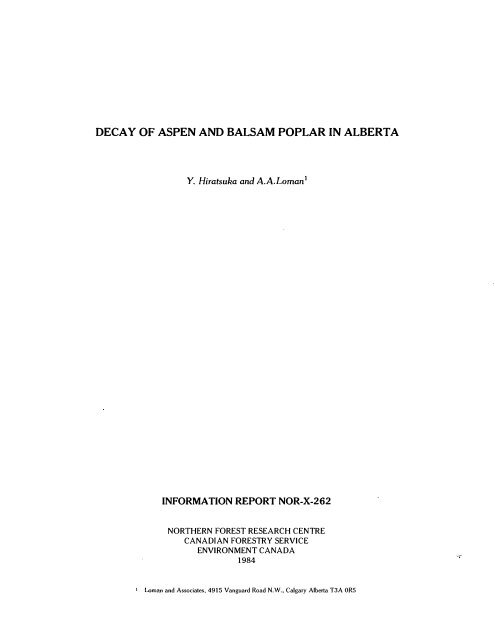
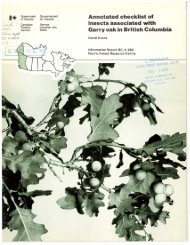
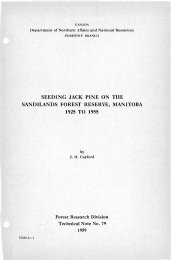
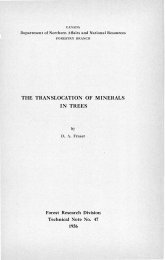
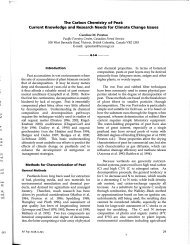


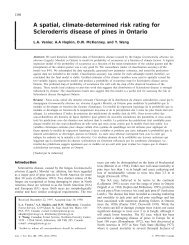

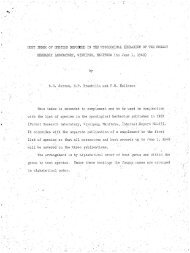
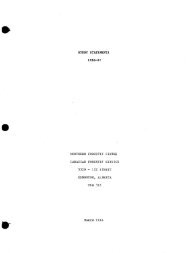
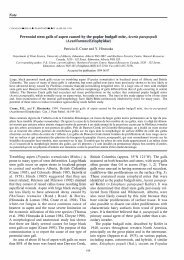
![Po],rell](https://img.yumpu.com/11946277/1/190x231/porell.jpg?quality=85)
